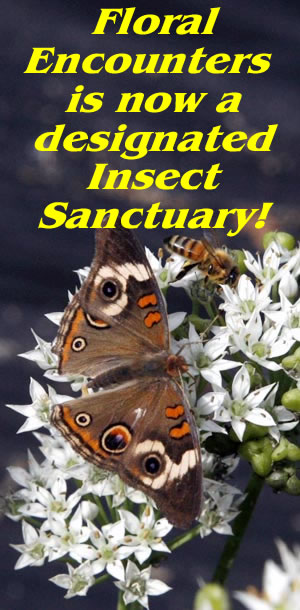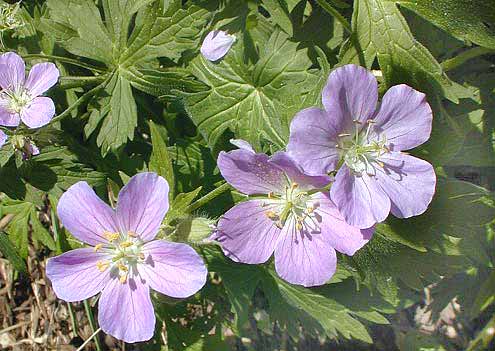Wild Geranium or Wild Cranesbill is a lovely native woodland edge perennial plant. With a profusion of purple to lilac flowers blooming for a month in late spring. it prefers full sun or dappled shade that is found under large deciduous trees in open woodland and will happily naturalize there. It takes little or no maintenance once established and in most cases no additional water. It does like a moist soil for best results but will tolerated drier soils. If the soil goes very dry it will go dormant until the following spring. Ideal for woodland edges or naturalizing in a woodland area. Deer might eat it, some people have no trouble others find they eat it. Depends on how hungry the deer are. May need protection if you have a high deer problem. Easy to grow and no trouble afterwards, although it will spread it never becomes invasive.
Description of Wild Geranium (Geranium maculatum).
A tough native woodland perennial herb hardy to zone 3 (some say only 5). The
plants produce a loose cluster of basal leaves which are dark green in color
and can mound from 12 - 28" (30 - 71cm) in height and spreading about 12-
18" (30 - 45 cm). The leaves are up to six inches (15 cm) across with five
deep lobes, although sometimes two are so deeply clefted that it appears that
there are seven lobes. The leaf margin is irregular and usually coarsely toothed.
The leaves are covered in white hairs, which are fine on the upper surface but
quite coarse on the lower surface. The flower stems arise in late spring or
early summer and come directly from the thick branched rhizomes where they were
set the previous year. Each flower stalk has one pair of leaves, similar in
shape to the basal ones but smaller and can be up to 6" (15 cm) long and
very hairy. The flowers are borne at the top of hairy stems in loose clusters
of 1-5. Each flower is about 1 - 1 ½" (2.5 - 3.8 cm) wide and has
five rounded pink to lavender colored petals; sometimes they are darker and
rarely white with slightly darker lines running to the flower's center. Flowering
lasts about a month. After blooming the fruits are produced. These consist of
a long central beak like column with five basal cells. The pod resembles a crane's
head which gives the plant one of its common names. When ripe the seed pods
curl upward and backward to spring open expelling the seeds up to 30 feet (9
m) from the mother plant.
Cultivation of Wild Geranium (Geranium maculatum).
This is an extremely easy woodland edge plant to grow. It likes full sun to
slight shade in rich soil with plenty of organic material. It prefers moist
to slightly dry conditions but may also grow in wetter conditions and does not
mind clay soils provided they do not dry out. The more sunshine it gets the
more prolifically it will flower provided there is sufficient moisture. Ideal
under trees where there is plenty of dappled sunlight or on the edges of trees
where there is plenty of sunshine throughout the day. This is especially true
for larger woodland trees such as oaks and hickories. For smaller deciduous
trees keep to the edges of the tree line until established. It will not grow
under pine trees.
It is best to plant on the edges of a woodland area unless there is plenty of
dappled sunlight in the woodland. When established the plant will naturalize
into the other areas where it feels it can grow and establish a larger colony.
Once established it takes little care or maintenance. It will spread with rhizomes
and seed but never becomes invasive.
Wild Geranium usually keeps its leaves throughout the season but if soil becomes
dryer it will die back after fruits are set. In these conditions leaves will
turn yellow and plant goes dormant until next spring.
Growing Wild Geranium
(Geranium maculatum) from Seed.
Seed needs stratification before it can germinate. (At present our seeds are
not stratified). Seed can either be sown directly outdoors in the fall and utilize
natural stratification or using artificial stratification.
Seeds can be sown in pots in two ways. In either case sow seeds in cell trays
for flats, then either place these outside during the winter months, best on
a bench or table near the house where you can keep an eye on them, or placed
in a cold cellar or detached unheated garage (not one attached to the house:
they stay too warm even if you don't heat them). Seeds usually germinate after
2-3 months of cold stratification and can then be potted on ready for planting
out as any other plant. Plants from seed usually flower in their second or sometimes
third year, but if treated well to begin with some may flower in the first year.
Problems with Wild Geranium (Geranium maculatum)
This plant has few pests. Slugs do like to eat it and it may get aphids. Sometimes
the deer will eat the flowers and occasionally the foliage. They may eat the
whole plant if their populations are high and pressure for food is great. If
so a deer fence will be necessary to protect plants.
Harvesting Wild Geranium (Geranium maculatum)
The rhizome or underground stem of cranesbill is dug out just as the plant is
coming into flower as this is the time when the medical compounds are most concentrated
and active. The roots are then washed sliced and dried for future use.
Medicinal Uses of Wild Geranium (Geranium maculatum).
The whole plant can be used but most commonly the roots. These are highly antiseptic
and are used most commonly to treat irritable bowel syndrome. However they are
also used for diarrhea, dysentery, hemorrhoids, cholera, kidney complaints and
a wide range of other ailments. Since they help in blood coagulation they are
used to help heal wounds and may be used to help dismemorrhea (profuse menstrual
bleeding) and vaginal discharges and other bleeding problems. The roots have
a very high tannin content making them an astringent and are used to lessen
inflammation, hemorrhoids, thrush, vaginal discharges and inflammations of the
mouth.
OTHER NAMES
Alumroot, alum root, alum bloom, American Cranesbill, Cranesbill, spotted cranesbill,
wild cranesbill, Dovefoot, Old-maid's-nightcap, Shameface, Wild Geranium, spotted
geranium, wood geranium,








